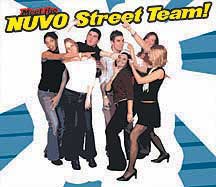Hawkers Mingle with Public in Bars and Theaters to Promote Papers
Visiting a rival business one evening, an Indianapolis bar owner noticed a few patrons doing more than just having drinks with the other customers. They took pictures with the drinkers, circulated among the crowd, handed out free stuff and were generally welcomed as though the Stones — or at least their road crew — had dropped by on tour.
The convivial group turned out to be no roadies, but the well-trained NUVO street marketing team on the loose in Indiana’s capital. So impressed was the visiting bar owner with the buzz the alt-weekly’s team stirred up that he contacted NUVO Promotions Manager Bill Skaggs to learn how he could draw Skaggs’ team to his bar by advertising in the paper.
“It’s almost like we’re marketing them as an entity,” or as celebrities, Skaggs says of his team of 15 part-time staff.
Each spring, Skaggs recruits on local campuses while handing out NUVO’s Night Life guide. He looks for students who really know the publication and, beyond that, have an interest in marketing or newspapers as a career.
Music industry revived street teams
NUVO and other alt-weeklies that use street teams are simply taking a page from the music industry they cover so well. That industry revived the practice of “street marketing”– promoting a product by having workers infiltrate the public and push it, either through conspicuous usage or by handing out printed materials.
Boston’s Weekly Dig has used street teams since shortly after the paper’s inception more than four years ago. The strategy was familiar to Ad/Marketing Director Graham Wilson, who used to work with street teams that handed out printed stickers, patches and flyers to promote bands. Those tactics evolved from earlier, illegal underground methods of drawing attention to bands, such as covering public property with graffiti and stickers, he says. He believes the rap group Wu-Tang Clan was the first band to bring this type of marketing from the underground into the mainstream.
Street marketing as a means of promoting entertainment “could go all the way back to Barnum and Bailey,” he says.
Dr. Eugene Fram, a marketing professor at Rochester Institute of Technology in New York, traces the practice back further. “All marketing was virtually done in fairs and in the streets in medieval times,” he says.
In the United States, 19th-century pack peddlers carried their wares door to door or displayed them from wagons. Newspapers hired hawkers to draw attention to their scoops. Modern street marketing often borrows familiar forms from the past, such as booths and carts, and uses them to offer everything from free samples of new soda to pens promoting cable television providers.
Marketers must reach audience at its level
Whether the product is soda, cable TV or newspapers, the first step to successful marketing is knowing your target audience and how to appeal to it.
Lucas Beddows, founder of On-Point Marketing and Promotions in San Diego, put himself through college in the early 1990s by heading a street crew of 50 for event marketing. He now helps companies such as IBM and Nike market with street teams and understands the importance of using the right people to promote certain products.
“Say you have a new urban product,” he says. “You really don’t want to send a bunch of white suburbanites into an urban neighborhood to sell an urban product. It has no validation.” Basic street marketing, he says, involves “going out and interacting with other members of a target market.”
Because most alt-weeklies want to appeal to a readership of college-aged to thirty-somethings, papers that use street teams tend to hire mostly college students to do the work. It makes sense to place teams where they can infiltrate the target audience. Bars are prime gathering spots; so are movie theaters.
Pittsburgh City Paper Marketing Director Traci Schneider says her paper has been very successful at doing movie premieres.
Kellee Maize, who was hired as a full-time promotions coordinator a year ago, goes to at least one opening or advance screening a week at various theaters, where she hands out copies of City Paper and promotional freebies. Often, the paper gets free passes from studios, which it makes available at area retailers to promote both the movie and the paper. The publication also piggybacks street marketing efforts onto the local events and festivals it sponsors by placing staffed booths at all of them.
Sometimes special occasions crop up at alt-weeklies that call for even more eye-catching marketing methods. To promote Philadelphia Weekly’s redesign, the publication’s editorial and sales staff manned busy downtown intersections on April 7, passing out papers, says Marketing Director Scott Santo. Staff members all wore shirts printed with the paper’s new logo: PW. The paper uses the same tactic for several special issues throughout the year.
PW also printed paper coffee cup sleeves for 10 independent local coffee shops. And it put PW table tents (menu holders) and matchbooks in local clubs, bars and restaurants where members of the paper’s target demographic tend to hang out. Santo notes that these business owners are “willing to play along” because they’re familiar with PW, and some advertise in the publication.
The cooperation of other businesses seems essential to street marketing. “Most of the places we go, we try to check out ahead of time and make sure it’s OK with them,” says NUVO’s Skaggs, of passing out flyers in Indianapolis’ bar district for the paper’s annual Tribe Vibe party, which features some of the region’s best musicians.
Wilson says his street teams often work along the Dig’s regular distribution stops to post or hand out flyers and are careful to respect individual businesses by not using staples where they’re not wanted, or by refraining from putting up flyers at all in off-limits areas. If residents of a certain neighborhood regard flyers as litter, it’s counterproductive to a street team’s efforts to post them there.
“I think I’m too cautious for most people’s tastes,” says Lei Ana Green of Honolulu Weekly, who has put banners and balloons up on signs and public property while decorating for events the paper sponsored. She is not willing to go beyond that, though, and risk violating an ordinance.
Paper’s size can limit street-team approach
Green, like Maize and Skaggs, is her paper’s promotions coordinator. Unlike them, she is also its office manager.
“We’re a really small place,” she explains. “We just started to take a more aggressive approach.” Green has led promotions for several months, and the paper recently hired local marketing consultant Claudette Bond to help with marketing and sales.
Green and six unpaid interns — recruited through ads in the paper and postings at local universities — work festivals and movie premieres. Team members hit a few places and put in one day each week at the office; each intern commits to three months.
Having even a promotions coordinator on staff is a luxury for many papers in the Association of Alternative Newsweeklies; being able to recruit a team is a bonus. To recover the expense, some papers rent their teams to other businesses that need a marketing boost. The Dig, for example, now uses its teams less for its own promotions and more to distribute flyers and hang posters for other clients. Recently, for example, the team passed out candy for Hershey’s. Wilson has 10 to 12 team members he uses about every other week in the spring.
NUVO is partnering with Miller Lite to jointly promote the beer and the paper at bars in which the street team already has a presence, says team member Andy Ehle, a junior at Indiana University Bloomington. Miller also advertises in NUVO.
Students like Ehle who join the NUVO team average two years on the job. Experienced team members train the new recruits. There’s more to the work than passing out swag — hawkers must be able to intelligently answer questions put to them on the street.
“You learn how to deal with people,” says Ehle, a prospective law student. “You meet every different type, from people who hate the paper, to those who really like it. … Even though our paper is free, you still kind of have to ‘sell’ it.”
Ann Hinch is a freelance reporter based in Knoxville, Tenn.








